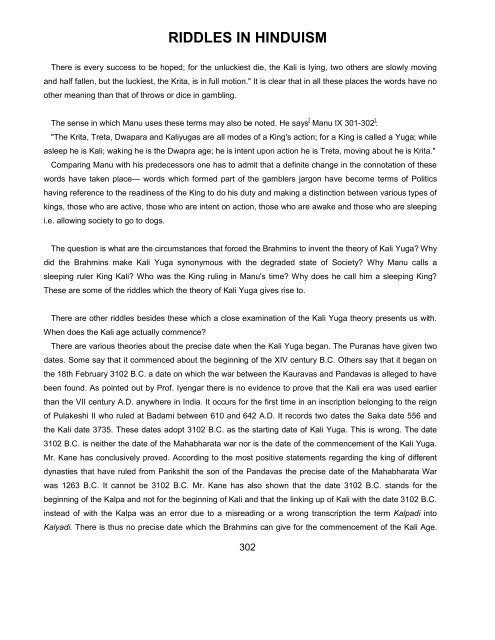You also want an ePaper? Increase the reach of your titles
YUMPU automatically turns print PDFs into web optimized ePapers that Google loves.
RIDDLES IN HINDUISM<br />
There is every success to be hoped; for the unluckiest die, the Kali is ly<strong>in</strong>g, two others are slowly mov<strong>in</strong>g<br />
and half fallen, but the luckiest, the Krita, is <strong>in</strong> full motion." It is clear that <strong>in</strong> all these places the words have no<br />
other mean<strong>in</strong>g than that of throws or dice <strong>in</strong> gambl<strong>in</strong>g.<br />
The sense <strong>in</strong> which Manu uses these terms may also be noted. He says [ Manu IX 301-302 ] :<br />
"The Krita, Treta, Dwapara and Kaliyugas are all modes of a K<strong>in</strong>g's action; for a K<strong>in</strong>g is called a Yuga; while<br />
asleep he is Kali; wak<strong>in</strong>g he is the Dwapra age; he is <strong>in</strong>tent upon action he is Treta, mov<strong>in</strong>g about he is Krita."<br />
Compar<strong>in</strong>g Manu with his predecessors one has to admit that a def<strong>in</strong>ite change <strong>in</strong> the connotation of these<br />
words have taken place— words which formed part of the gamblers jargon have become terms of Politics<br />
hav<strong>in</strong>g reference to the read<strong>in</strong>ess of the K<strong>in</strong>g to do his duty and mak<strong>in</strong>g a dist<strong>in</strong>ction between various types of<br />
k<strong>in</strong>gs, those who are active, those who are <strong>in</strong>tent on action, those who are awake and those who are sleep<strong>in</strong>g<br />
i.e. allow<strong>in</strong>g society to go to dogs.<br />
The question is what are the circumstances that forced the Brahm<strong>in</strong>s to <strong>in</strong>vent the theory of Kali Yuga? Why<br />
did the Brahm<strong>in</strong>s make Kali Yuga synonymous with the degraded state of Society? Why Manu calls a<br />
sleep<strong>in</strong>g ruler K<strong>in</strong>g Kali? Who was the K<strong>in</strong>g rul<strong>in</strong>g <strong>in</strong> Manu's time? Why does he call him a sleep<strong>in</strong>g K<strong>in</strong>g?<br />
These are some of the riddles which the theory of Kali Yuga gives rise to.<br />
There are other riddles besides these which a close exam<strong>in</strong>ation of the Kali Yuga theory presents us with.<br />
When does the Kali age actually commence?<br />
There are various theories about the precise date when the Kali Yuga began. The Puranas have given two<br />
dates. Some say that it commenced about the beg<strong>in</strong>n<strong>in</strong>g of the XIV century B.C. Others say that it began on<br />
the 18th February 3102 B.C. a date on which the war between the Kauravas and Pandavas is alleged to have<br />
been found. As po<strong>in</strong>ted out by Prof. Iyengar there is no evidence to prove that the Kali era was used earlier<br />
than the VII century A.D. anywhere <strong>in</strong> India. It occurs for the first time <strong>in</strong> an <strong>in</strong>scription belong<strong>in</strong>g to the reign<br />
of Pulakeshi II who ruled at Badami between 610 and 642 A.D. It records two dates the Saka date 556 and<br />
the Kali date 3735. These dates adopt 3102 B.C. as the start<strong>in</strong>g date of Kali Yuga. This is wrong. The date<br />
3102 B.C. is neither the date of the Mahabharata war nor is the date of the commencement of the Kali Yuga.<br />
Mr. Kane has conclusively proved. Accord<strong>in</strong>g to the most positive statements regard<strong>in</strong>g the k<strong>in</strong>g of different<br />
dynasties that have ruled from Parikshit the son of the Pandavas the precise date of the Mahabharata War<br />
was 1263 B.C. It cannot be 3102 B.C. Mr. Kane has also shown that the date 3102 B.C. stands for the<br />
beg<strong>in</strong>n<strong>in</strong>g of the Kalpa and not for the beg<strong>in</strong>n<strong>in</strong>g of Kali and that the l<strong>in</strong>k<strong>in</strong>g up of Kali with the date 3102 B.C.<br />
<strong>in</strong>stead of with the Kalpa was an error due to a misread<strong>in</strong>g or a wrong transcription the term Kalpadi <strong>in</strong>to<br />
Kalyadi. There is thus no precise date which the Brahm<strong>in</strong>s can give for the commencement of the Kali Age.<br />
302


















